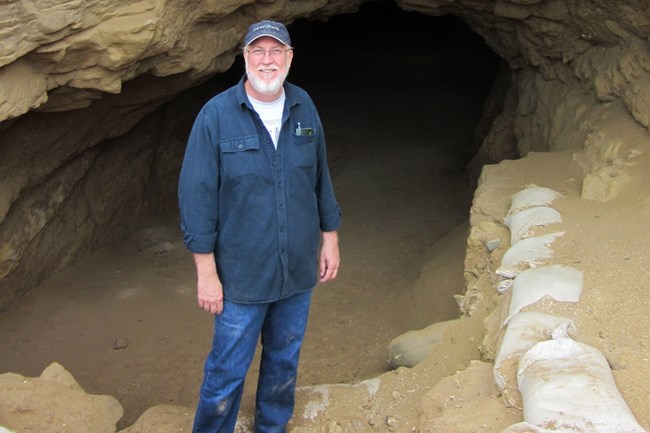
Chapter 12
Steve Schwartz, US Navy archeologist (retired), San Nicolas Island, discusses the location of the whalebone hut found in the 1930s.
In 1939, archeologist and historian Arthur Woodward of the Los Angeles County Museum of Natural History visited San Nicolas Island. He brought with him a copy of Captain Nidever’s and Carl Dittman’s accounts of the discovery of the Lone Woman in 1853. Using the accounts, Woodward was able to find the approximate location where the Lone Woman was found in a small hut, or windbreak. He found a scattering of whalebones like the ones described as being part of the Lone Woman’s windbreak. From this discovery, Woodward believed he had found the remains of the Lone Woman’s actual hut.
In 1940, he returned and photographed the site as he found it. He then reconstructed part of the hut by standing the whalebones up on edge. He photographed his assistant sitting in the reconstructed hut. This looked a lot like the scene Carl Dittman may have observed when he first spied the Lone Woman.
Using Woodward’s field notes and photographs, I was able to relocate this precise spot. There are still remains of whalebones at the site today. The location is on top of a sand dune at the northwest end of San Nicolas Island. There is evidence of previous occupation in the form of a midden deposit (trash or refuse heap).
Based on my research, I agree with Woodward that this is likely the location where the Lone Woman was first seen. However, since Dittman observed three huts on the dune as he approached the Lone Woman, I cannot be certain that this is the precise spot where she was found. Future archeological excavations could reveal evidence that would securely pinpoint the exact location.
-
Listen to chapter 12 entry
Learn about a whalebone hut found on San Nicolas Island.
Chapter 14
Steve Schwartz, US Navy archeologist (retired), San Nicolas Island, discusses his search for the lost Indian Cave on San Nicolas Island. This is a shoreline cave that may have been one of the temporary shelters used by the Lone Woman.Finding the lost Indian Cave (Lone Woman’s cave) was the highlight of my 25-year career on the island. The early accounts said she had lived in a cave near where she was found in her small hut, or windbreak.
Some explorers had been out to the island in the years afterwards. They found the cave, went into it, and found artifacts in the cave. Ever since, however, a number of archeologists had been on the island to survey for sites, but an occupation cave (a cave in which people lived) was never found.
It seemed to me that the cave must exist somewhere, but had collapsed or become buried over the years so no one was able to find it. This began my quest to find the cave.
After making several failed attempts to find the cave in the field, I had almost given up when a vital piece of information came to light. An 1879 map actually showed the location of the cave. By using the map and the field notes that accompany the map, I was finally able to pinpoint the precise location of the cave.
Digging out still took a lot of hard work by archeology students from California State University, Los Angeles. After many days of digging, we had removed enough of the sand that had filled the cave to finally expose its opening. Before we could see inside the cave, we had to remove over 40,000 buckets of sand!
The search had taken over 20 years. It was an amazing experience.
-
Listen to chapter 14 entry
Learn about the long search for the lost Indian Cave.
Chapter 29
Steve Schwartz, US Navy archeologist (retired), San Nicolas Island, discusses the retrieval of the Lone Woman in 1853 and the location where the hunting party stayed with the Lone Woman while they were on the island.By using the accounts of Captain Nidever and Carl Dittman, it is possible to find the location on the island where the otter hunting party found the Lone Woman, and then follow their trail back to the otter hunters’ camp.
The camp was on a beach in the center of the northern coastline. This location is an excellent spot for landing small boats. It has a spring of fresh water in a small cave and also has a natural windbreak formed by a sandstone cliff at one end. Many early explorers and hunters camped at this site.
Nidever and Dittman recorded the events relating to the Lone Woman’s discovery in 1853 in two separate documents. According to these records, the Lone Woman led them from her hut to a spring on a nearby beach, where she had put some items in rocky crevices. She got her items and then stopped at another spring to bathe. After this, they all went to the hunting camp.
Later, the men took her out to their boat, which was anchored offshore, to keep her from running away. After a day or so, it appeared that she would not run off. They took her back to their camp and returned to hunting otter. She kept herself busy collecting wood and water for the camp and weaving baskets.
She remained in the otter hunters’ camp for about a month. Then she was taken from San Nicolas Island to the town of Santa Barbara on the mainland.
-
Listen to chapter 29 entry
Learn about the 1853 discovery of the Lone Woman on San Nicolas Island.
Last updated: December 11, 2018
